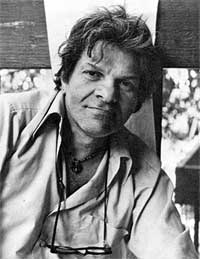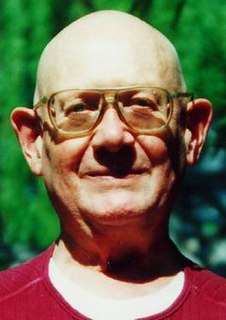Related Research Articles

Irwin Allen Ginsberg was an American poet and writer. As a student at Columbia University in the 1940s, he began friendships with William S. Burroughs and Jack Kerouac, forming the core of the Beat Generation. He vigorously opposed militarism, economic materialism, and sexual repression, and he embodied various aspects of this counterculture with his views on drugs, sex, multiculturalism, hostility to bureaucracy, and openness to Eastern religions.

Jean-Louis Lebris de Kérouac, known as Jack Kerouac, was an American novelist of French Canadian ancestry, who, alongside William S. Burroughs and Allen Ginsberg, was a pioneer of the Beat Generation.
The Beat Generation was a literary movement started by a group of authors whose work explored and influenced American culture and politics in the post-war era. The bulk of their work was published and popularized throughout the 1950s. The central elements of Beat culture are the rejection of standard narrative values, making a spiritual quest, the exploration of American and Eastern religions, the rejection of economic materialism, explicit portrayals of the human condition, experimentation with psychedelic drugs, and sexual liberation and exploration.

Gregory Nunzio Corso was an American poet and a key member of the Beat movement. He was the youngest of the inner circle of Beat Generation writers.

Lewis Barrett Welch Jr. was an American poet associated with the Beat generation literary movement.

The term San Francisco Renaissance is used as a global designation for a range of poetic activity centered on San Francisco, which brought it to prominence as a hub of the American poetry avant-garde in the 1950s. However, others felt this renaissance was a broader phenomenon and should be seen as also encompassing the visual and performing arts, philosophy, cross-cultural interests, and new social sensibilities.

Philip Glenn Whalen was an American poet, Zen Buddhist, and a key figure in the San Francisco Renaissance and close to the Beat generation.
The Evergreen Review is a U.S.-based literary magazine. Its publisher is John Oakes and its editor-in-chief is Dale Peck. The Evergreen Review was founded by Barney Rosset, publisher of Grove Press. It existed in print from 1957 until 1984, and was re-launched online in 1998, and again in 2017. Its lasting impact can be seen in the March–April 1960 issue, which included work by Albert Camus, Lawrence Ferlinghetti, Bertolt Brecht and LeRoi Jones, as well as Edward Albee's first play, The Zoo Story (1958). The Camus piece was a reprint of "Reflections on the Guillotine", first published in English in the Review in 1957 and reprinted on this occasion as the magazine's "contribution to the worldwide debate on the problem of capital punishment and, more specifically, the case of Caryl Whittier Chessman." Its commitment to the progressive side of the political spectrum has been consistent, with early stance for civil rights and against the Vietnam War. The image of Che Guevara that first appeared on the cover of its February 1968 issue, designed by Paul Davis and based on a photograph by Alberto Korda, became a popular symbol of resistance.

The City Lights Pocket Poets Series is a series of poetry collections published by Lawrence Ferlinghetti and City Lights Books of San Francisco since August 1955.

The Six Gallery reading was an important poetry event that took place on Friday, October 7, 1955, at 3119 Fillmore Street in San Francisco.
Barry Miles is an English author known for his participation in and writing on the subjects of the 1960s London underground and counterculture. He is the author of numerous books and his work has also regularly appeared in left-wing papers such as The Guardian. In the 1960s, he was co-owner of the Indica Gallery and helped start the independent newspaper International Times.

Harold Norse was an American writer who created a body of work using the American idiom of everyday language and images. One of the expatriate artists of the Beat generation, Norse was widely published and anthologized.
Donald Merriam Allen was an editor, publisher and translator of contemporary American literature. He is best known for his project The New American Poetry 1945-1960 (1960), one of the anthologies of contemporary American writing he released.
Chicago Review is a literary magazine founded in 1946 and published quarterly in the Humanities Division at the University of Chicago. The magazine features contemporary poetry, fiction, and criticism, often publishing works in translation and special features in double issues.

Moody Street Irregulars was an American publication dedicated to the history and the cultural influences of Jack Kerouac and the Beat Generation. Edited and published by Joy Walsh, it featured articles, memoirs, reviews and poetry. Published from Clarence Center, New York, it had a run of 28 issues from Winter 1978 to 1992. Some issues were edited by Walsh with Michael Basinski and Ana Pine.
Larry Fagin was an American poet, editor, publisher, and teacher, and a member of the New York School.
Naked Lens: Beat Cinema is a book by Jack Sargeant about the relationship between Beat culture and underground film. First published by Creation Books in 1997, the book has been subsequently republished in two different English language editions, by Creation Books in 2001 and Soft Skull in 2008. The book also features contributions from Tessa Hughes-Freeland, Stephanie Watson, and Arthur and Corrine Cantrill.
The Outlaw Bible of American Poetry, edited by Alan Kaufman, is an anthology of American underground poets spanning the post-war era to the present day. First published in 1999, the collection features work from several notable poets, including Jack Micheline, Patti Smith, Harold Norse, David Trinidad, Tuli Kupferberg, D.A. Levy, Bob Kaufman, Jim Chandler, Jim Brodey, Daniel Higgs, ruth weiss, Jack Kerouac, Bonny Finberg, David Lerner, Richard Brautigan, Allen Ginsberg, Tom Waits, William S. Burroughs, Carlos ac Libera, Ken Kesey, Justin Chin, DianDi Prima, Charles Bukowski, and FrancEyE, among others. S.A. Griffin served as a contributing editor.
Nomad was an avant-garde literary magazine that Anthony Linick and Donald Factor edited and published in Los Angeles between 1959 and 1962. The first issue came out in the winter of 1959. Linick and Factor were particularly drawn to the poetry and writing of the Beat Generation, who wrote of their own, frequently chaotic, lives.

The Beat Museum is located in San Francisco, California and is dedicated to preserving the memory and works of the Beat Generation.
References
- ↑ Rich Weidman (1 September 2015). The Beat Generation FAQ: All That's Left to Know About the Angelheaded Hipsters. Backbeat Books. p. 264. ISBN 978-1-61713-634-4.
- ↑ Tom Clark
- ↑ Guardian